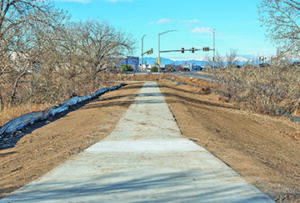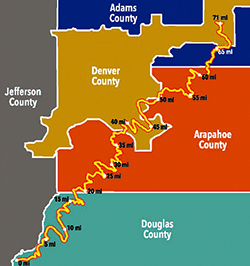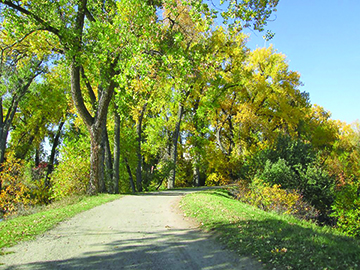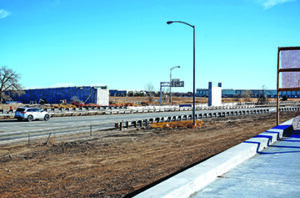by Jessica Hughes
The High Line Canal is a man-made waterway begun in 1881 for the purpose of irrigating land in Denver and eastward. Beginning at a diversion dam off the South Platte 1.8 miles above the mouth of Watterton Canyon it runs a meandering 71 miles through Douglas, Arapahoe, Denver, and Adams Counties and ending near Green Valley Ranch. It is based on the “high line principal” of following the contours of the land to allow the water to flow by gravity with a minimal drop in elevation per mile. As a result, the Canal has many twists and turns.
The Canal was never a very efficient vehicle for providing water for irrigation and it no longer does so. But over the years it has become a major source of recreation. A maintenance road ran aside the High Line Canal to assist in making repairs to the Canal and is now called the High Line Canal Trail. It is now open to all non-motorized traffic. Parts of the trail are dirt while others are concreted.
The High Line Canal I-70 construction project, which began one year ago, is slated to be finished in early 2024. The City of Aurora in collaboration with American Civil Constructors, will close the longest gap (three miles) of the 71-mile High Line Canal Trail from Colfax Ave. to the trail north of I-70 when the project is complete.
This new section of the trail will connect Northeast Denver to the rest of the Canal with a continuous eight-foot-wide concrete trail, two pedestrian bridges, including the I-70 overpass, another to cross the Canal at Smith Rd., upgraded railroad crossing for pedestrians and cyclist safety, and more.

The new three-mile section of the High Line Canal Trail bridges the gap between Colfax Ave. to the north of I-70 with an eight-foot-wide concrete trail.
“When complete this project will provide close-to-home, accessible recreation opportunities to the diverse population that use this section,” says Harriett Crittenden LaMair, the High Line Conservancy Executive Director.
The High Line Canal Conservancy was founded in 2014 to permanently protect the 71-mile High Line Canal and unify all partners to implement The Plan for the High Line Canal. Partners include Denver Water, along with support of 11 jurisdictions where the Canal is located, including the City of Aurora — the lead partner for the I-70 project.
The High Line Canal Trail twists and turns through the most populated areas of Colorado, crossing multiple and varied communities in the Metro area. With over 350,000 residents living within one mile of the Canal and approximately one million people using the trail annually, efforts to improve the trail system are more important than ever.
 Since the 1920s, the Canal has been owned by Denver Water as a part of Denver’s water delivery system since the 1880s. Over the last 100+ years, the Canal’s evolution has gone from utilitarian efforts of conveying water, to a community-wide recreational and environmental hub for locals and visitors alike.
Since the 1920s, the Canal has been owned by Denver Water as a part of Denver’s water delivery system since the 1880s. Over the last 100+ years, the Canal’s evolution has gone from utilitarian efforts of conveying water, to a community-wide recreational and environmental hub for locals and visitors alike.
There will also be a major focus on improvements to the northern 28 miles of the Canal due to historic underinvestment. “This area is also some of the most diverse communities in the state,” says Crittenden LaMair. “With some of these improvements we strive to bring more equity to outdoor access.”
To ensure adjacent communities were aligned, the conservancy led with a community-first mindset, working with anyone who wanted to be involved in the planning and development of future projects. “We worked with over 10,000 people who wanted to get involved with the design improvements of the Canal’s northern sections,” says Crittenden LaMair.
She also explains an important part of the project is to create trail improvements through a community-centered design process. “There are 28 schools within a quarter of a mile from the High Line Canal,” says Crittenden LaMair. “The Canal is an important community resource for moving and we want to encourage kids to use it for walking to and from the elementary schools.” But for the Conservancy, it isn’t only about walkability scores, it’s also about creating community activation zones where the community can come together.
“For example, there are proposed improvements for an outdoor classroom along the Canal by Green Valley Ranch’s Marrama Elementary school,” says Crittenden LaMair. “Another example includes Aurora’s Laredo Highline neighborhood, the Grandy Ditch Open Space, where there are proposed plans to include bike racks, a shade structure, and natural elements for neighbors to enjoy.”
Federal funds were granted to the City of Aurora for the I-70 project through the Denver Regional Council of Governments, with the city using capital improvement funding as a match. Additional funding came from the Conservation Trust Fund, Adams County Open Space Grant, and Adams County Open Space Tax Shareback with a total of $9.4 million invested in the project.
Overall, funding for the conservancy includes both public and private outlets — including all the conservancy’s jurisdictional partners, regional and national foundations, corporate partners, and over 2,500 annual private donors.
“We raise over 60% of our annual operating budget in November and December, in particular on Colorado Gives Day,” says Crittenden LaMair. “These are critical funds that keep our organization afloat and help to support all of the work that we do.” There are several ways in which individuals can help support the conservancy through bench and tree adoptions as gifts to commemorate someone special, monthly donations, corporate sponsorships, and volunteering opportunities.
Beyond the I-70 project, what does the future hold for the High Line Canal Trail? Crittenden LaMair says there are plans for enhancements to make the trail safer and more enjoyable for everyone, plus, ongoing ecological restoration and maintenance for recreational uses across all 71 miles.
“This year we will have more exciting updates about next steps in protecting the Canal for future generations,” says Crittenden LaMair. “It’s important to continue improvement along the Canal because it’s a recreation hub with easy access to the outdoors in the middle of the city, a place where youth can connect with nature, free outdoor recreation for local communities, build biodiversity and ecological health in urban areas, and more. It really is a staple for those living in the metro area.”
Learn more about the High Line Canal Conservancy at highlinecanal.org.
Photos by Jessica Hughes




